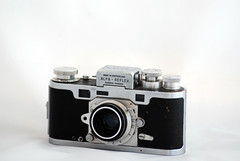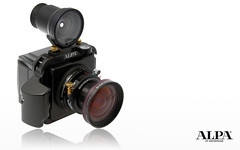Rebollo fr (talk | contribs) (toned down, there was no relationship between image quality and the Alpa bodies, Alpa was no lens maker) |
m (→Links) |
||
| (36 intermediate revisions by 17 users not shown) | |||
| Line 1: | Line 1: | ||
| + | {{Flickr image |
||
| − | '''ALPA''' is the brand name of successive generations of high-quality 35mm SLR cameras made by the Swiss manufacturer [[Pignons]] S.A. |
||
| + | | image_source=http://www.flickr.com/photos/cocktail_hour/4265167918/in/pool-camerapedia/ |
||
| + | | image=http://farm5.static.flickr.com/4012/4265167918_09729a23f1_m.jpg |
||
| + | | image_align=right |
||
| + | | image_text=Alpa Reflex II, 1945-52<br /><small>by Cocktail Hour</small> |
||
| + | }} |
||
| + | '''Alpa''' is the brand name of successive generations of high-quality [[35mm]] [[SLR]] cameras made by the Swiss watch part manufacturer [[Pignons]] S.A. It was originally designed by Jacques Bolsky/Bolsey before WW2 and there were several prototypes produced during the war with names like Bolca but the original 'Reflex' and the Standard non-reflex versions were released in 1944-5. The Type 3 Prisma Reflex of 1949 is one of the first prism SLR's made, just after the Contax S but equal with the Rectaflex. It featured a Kern 45 deg. prism and, unusually, still retained a coupled coincident rangefinder. |
||
| + | The Alpa was of an unusually solid construction, and featured a cast metal body with figured surfaces. Controls were unusual - the later models had a front-to-back wind lever and a unique extending rewind handle. The back of Alpas is the removable type, held by a central lock. This made it easy to attach specialised backs. Alpa made no lenses but favoured the 50mm f1.8 Kern Macro Switar, an exceptional lens which still commands very high prices and adapters are available to fit it to modern mirrorless cameras and Leica bodies. They cannot be used on other SLR's as Alpa used a very short film to lens mount distance, again to allow the attachment of a wide range of lenses. Lenses were made in Alpa mount by the top European manufacturers such as Schneider, Angenieux, Kinoptik and Kilfitt, as well as smaller optical suppliers such as Enna and Old Delft. A few lenses were made in Alpa mount by Japanese manufacturers Pentax and Chinon. Alpa also sold two Chinon-built SLRs, the Si2000 and Si3000, which used M42 and K bayonet lenses respectively. |
||
| − | The original design was called the Bolca Reflex and had been made by Jacques Bogopolsky, who was already the father of the [[Bolex]] movie camera (see [[Bolsey]]). The rights were bought by [[Pignons]] in 1942, who gave the camera the Alpa name. |
||
| − | + | Alpas were very expensive hand-made cameras, made of carefully selected materials, with many variants that could be produced on special order. Their style of niche marketing and bespoke production could not survive the onslaught of autofocus and other electronic innovations. The company ceased camera production in 1990 and liquidation was initiated. |
|
| + | ===Cameras=== |
||
| ⚫ | Later that year, the |
||
| + | {{Flickr image |
||
| + | | image_source=http://www.flickr.com/photos/echenique/3652783826/in/pool-camerapedia |
||
| + | | image=http://farm4.static.flickr.com/3325/3652783826_49ba57e34e_m.jpg |
||
| + | | image_align=right |
||
| + | | image_text=Alpa 12 TC<br /><small>by Carlos Echenique</small> |
||
| + | }}* Pignons era - consumer models |
||
| + | ** Alpa Standard rangefinder only) |
||
| + | ** Alpa-Reflex |
||
| + | ** Alpa Prisma Reflex,1949 (Kern 45 deg. prism finder and coupled rangefinder) |
||
| + | ** Alpa Model 4 'Alnea' (non-prism finder) |
||
| + | ** Apa Model 5 Alnea (Kern prism and optical finder) |
||
| + | ** Alpa Reflex Model 6 Alnea (Kern prism, split image focussing and optical finder) |
||
| + | ** Alpa Model 7 (Kern prism and vertical rangefinder) |
||
| + | ** Alpa Model 8 (Kern prism with split image focussing - rare) |
||
| + | ** Alpa Models 6b, 7b and 8b (had lever wind and instant return mirror) |
||
| + | ** Alpa Reflex 6c (new style with uncoupled meter and 90 degree prism). |
||
| + | ** Alpa Reflex 9d (CdS metering, TTL) |
||
| + | ** Alpa Reflex (9f (no meter) |
||
| + | ** Alpa Reflex 10d (TTL match needle metering, new style top plate |
||
| + | ** Alpa Reflex 11 (match diode metering, several models) |
||
| + | ** There were several variants of the Model 11 based on metering type (CdS or Silicon cells) and function. The best selling model was the 11a post camera with no finder and a fixed focus lens, and there were several scientific and medical models. |
||
| + | * Capaul & Weber era |
||
| + | **[[Alpa 12 TC]] |
||
| + | **[[Alpa 12 WA]] |
||
| + | ** Alpa 12 SWA |
||
| + | ** Alpa 12 MAX |
||
| + | ** Alpa 12 Metric |
||
| + | ** Alpa 12 XY |
||
| ⚫ | The Alpa trademark was purchased by new owners Capaul & Weber in 1996. Later that year, the Alpa name was revived for a prototype of a new, premium-level medium format camera, the Alpa 12. Production models of the [[Alpa 12 WA|12WA]], and 12/SWA (with built-in perspective control) followed in 1998. All of these cameras had a modular design that accepts a variety of superb wide-angle lenses from [[Rodenstock]], [[Carl Zeiss]], and [[Schneider]]. In 2007 the new enterprise became the '''ALPA Capaul & Weber AG'''. |
||
| − | ==External link== |
||
| + | == Links == |
||
| ⚫ | |||
| + | *[http://www.alpa.ch company homepage] |
||
| + | *[http://www.alpareflex.com Alpa Reflex Cameras from Switzerland] at [http://www.alpareflex.com alpareflex.com] |
||
| ⚫ | |||
| + | *[http://www.collection-appareils.fr/general/html/listeA_imagettes.php#Alpa Alpa Cameras] at www.collection-appareils.fr |
||
| + | *[http://www.butkus.org/chinon/alpa.htm Alpa English instruction manuals] at Orphancameras.com |
||
| ⚫ | |||
| + | |||
| ⚫ | |||
| + | *[http://jeanc.bouss1.free.fr/dossier_collection/cible.php?%20id=12 Alpa 6B] at [http://jeanc.bouss1.free.fr/dossier_collection/ Au fil des Images] (in French) |
||
| ⚫ | |||
| + | |||
| + | *[http://collectiblend.com/Cameras/Pignons/ Alpa Cameras Price Guide, Photos, Descriptions] at collectiblend.com |
||
| ⚫ | |||
| ⚫ | |||
| + | [[Category:Topography]] |
||
| ⚫ | |||
| + | [[Category:Camera makers]] |
||
Latest revision as of 11:36, 27 February 2020

|
| Alpa Reflex II, 1945-52 by Cocktail Hour |
Alpa is the brand name of successive generations of high-quality 35mm SLR cameras made by the Swiss watch part manufacturer Pignons S.A. It was originally designed by Jacques Bolsky/Bolsey before WW2 and there were several prototypes produced during the war with names like Bolca but the original 'Reflex' and the Standard non-reflex versions were released in 1944-5. The Type 3 Prisma Reflex of 1949 is one of the first prism SLR's made, just after the Contax S but equal with the Rectaflex. It featured a Kern 45 deg. prism and, unusually, still retained a coupled coincident rangefinder.
The Alpa was of an unusually solid construction, and featured a cast metal body with figured surfaces. Controls were unusual - the later models had a front-to-back wind lever and a unique extending rewind handle. The back of Alpas is the removable type, held by a central lock. This made it easy to attach specialised backs. Alpa made no lenses but favoured the 50mm f1.8 Kern Macro Switar, an exceptional lens which still commands very high prices and adapters are available to fit it to modern mirrorless cameras and Leica bodies. They cannot be used on other SLR's as Alpa used a very short film to lens mount distance, again to allow the attachment of a wide range of lenses. Lenses were made in Alpa mount by the top European manufacturers such as Schneider, Angenieux, Kinoptik and Kilfitt, as well as smaller optical suppliers such as Enna and Old Delft. A few lenses were made in Alpa mount by Japanese manufacturers Pentax and Chinon. Alpa also sold two Chinon-built SLRs, the Si2000 and Si3000, which used M42 and K bayonet lenses respectively.
Alpas were very expensive hand-made cameras, made of carefully selected materials, with many variants that could be produced on special order. Their style of niche marketing and bespoke production could not survive the onslaught of autofocus and other electronic innovations. The company ceased camera production in 1990 and liquidation was initiated.
Cameras[]

|
| Alpa 12 TC by Carlos Echenique |
* Pignons era - consumer models
- Alpa Standard rangefinder only)
- Alpa-Reflex
- Alpa Prisma Reflex,1949 (Kern 45 deg. prism finder and coupled rangefinder)
- Alpa Model 4 'Alnea' (non-prism finder)
- Apa Model 5 Alnea (Kern prism and optical finder)
- Alpa Reflex Model 6 Alnea (Kern prism, split image focussing and optical finder)
- Alpa Model 7 (Kern prism and vertical rangefinder)
- Alpa Model 8 (Kern prism with split image focussing - rare)
- Alpa Models 6b, 7b and 8b (had lever wind and instant return mirror)
- Alpa Reflex 6c (new style with uncoupled meter and 90 degree prism).
- Alpa Reflex 9d (CdS metering, TTL)
- Alpa Reflex (9f (no meter)
- Alpa Reflex 10d (TTL match needle metering, new style top plate
- Alpa Reflex 11 (match diode metering, several models)
- There were several variants of the Model 11 based on metering type (CdS or Silicon cells) and function. The best selling model was the 11a post camera with no finder and a fixed focus lens, and there were several scientific and medical models.
- Capaul & Weber era
- Alpa 12 TC
- Alpa 12 WA
- Alpa 12 SWA
- Alpa 12 MAX
- Alpa 12 Metric
- Alpa 12 XY
The Alpa trademark was purchased by new owners Capaul & Weber in 1996. Later that year, the Alpa name was revived for a prototype of a new, premium-level medium format camera, the Alpa 12. Production models of the 12WA, and 12/SWA (with built-in perspective control) followed in 1998. All of these cameras had a modular design that accepts a variety of superb wide-angle lenses from Rodenstock, Carl Zeiss, and Schneider. In 2007 the new enterprise became the ALPA Capaul & Weber AG.
Links[]
- company homepage
- Alpa Reflex Cameras from Switzerland at alpareflex.com
- Alpa Reflex Series D at Collection Even
- Alpa Cameras at www.collection-appareils.fr
- Alpa English instruction manuals at Orphancameras.com
- Alpa 6B at Au fil des Images (in French)
- Alpa Cameras Price Guide, Photos, Descriptions at collectiblend.com